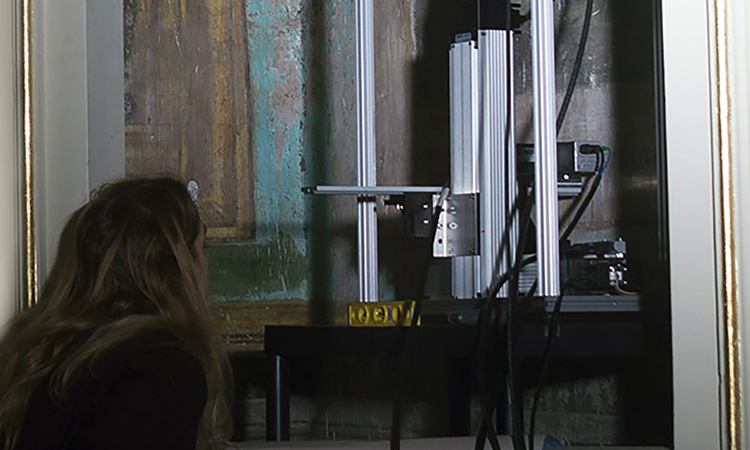 Corinna Koch Dandelo performs terahertz scanning of an 18th-century fresco discovered during renovations of a Sicilian church. [Cultural Heritage Science Open Source]
Corinna Koch Dandelo performs terahertz scanning of an 18th-century fresco discovered during renovations of a Sicilian church. [Cultural Heritage Science Open Source]
To the casual museum visitor, a Stone Age clay pot, a Roman vase or an Old Masters painting might be interesting only because of how it looks on the surface. Specialists, however, know that a wealth of information lies beneath.
Analyzing the layers of paint and supporting materials in a priceless artwork, for example, tells us how the artist built up translucent and opaque strata to achieve delicate visual illusions. Looking beneath the surface can yield clues to the artist’s thought process: did the artist meticulously draw the design with a pencil or build up the picture from freehand brush strokes? Is the support structure beneath the outermost layers of paint or ceramic glaze robust, or could it be deteriorating?
Archaeologists, art historians and museum curators wish to explore hidden details of cultural artifacts without damaging or destroying them. Over the last decade, researchers have investigated the use of imaging and spectroscopy at terahertz frequencies to study these objects non-destructively. Since terahertz rays penetrate artifacts more deeply than higher frequencies, the technology complements other types of photon-based analysis in the X-ray, visible and infrared regions.
To understand the role terahertz techniques play in nondestructive testing, think of an object—a painting, say, or a ceramic bowl—as a layered sandwich.
Researchers around the world have studied many kinds of artifacts with terahertz rays: subsurface fractures in medieval and Renaissance paintings, deep layers of terracotta and lacquerware vessels, stone fragments from medieval buildings, hand-drawn manuscripts, and murals that might have been painted over other artwork. Some physicists and engineers work full-time in the emerging specialty of cultural-heritage science, while others have participated in one or two cultural-heritage projects alongside more conventional research.
“We are always looking for methods that are non-contact, non-invasive,” says Antonino Cosentino, an Italian physicist and owner of Cultural Heritage Science Open Source (CHSOS), a consulting firm offering instruction in terahertz imaging and other optical technologies. “It is better not to take samples from our precious Mona Lisa.”
To understand the role terahertz techniques play in nondestructive testing, think of an object—a painting, say, or a ceramic bowl—as a layered sandwich. Ultraviolet rays hardly get through the topmost layer, which in oil paintings is generally a layer of protective varnish. Infrared light can penetrate the visible paint to get to the artist’s underlying sketch, but not much farther. Terahertz rays can reach the underlying surface-preparation methods and support media of the painting; they can show the thickness of the substrates under the art or reveal the grain of a slab of wood from a long-dead tree.
Terahertz Technology Fills In the Gap
Within the electromagnetic spectrum, terahertz technologies fill in a gap that has not been previously exploited for archaeological investigation and fine-art conservation. Here are some ways specialists in those fields use other wavelengths for their investigations.
Radio waves: Ground-penetrating radar uses reflections from microwave (gigahertz or megahertz) radiation beams to locate buried artifacts.
Infrared light: Since the 1960s, art specialists have used infrared reflectography, in which a painting is imaged under reflected near-infrared light. This technique works well for artworks that have infrared-absorbing sketch materials layered with highly infrared-reflective pigments. However, it works less well if a painting consists solely of reflective substances—or of absorbers—in this wavelength range.
Analysis by Fourier transform infrared (FTIR) spectroscopy and microscopy generally involves removal and destruction of a tiny sample of the material under investigation. The technique is “microdestructive,” rather than nondestructive. Scientists can grind up the sample, mix it with a powder transparent at infrared wavelengths and measure its transmission of infrared light, or they can analyze the reflectance off the surface of an opaque specimen. Most FTIR spectroscopic analysis of cultural artifacts is done in the mid-infrared region, from 2.5 μm to 16 μm in wavelength. FTIR microscopy—an FTIR spectroscope combined with an optical microscope—can characterize thin layers or small particles. In 2010, an Italian team suggested that FTIR microscopy may be particularly good at assessing the performance of protective materials, such as varnish, applied to paintings.
Visible light: High-resolution photographic images preserve the way art looks at a point in time, before or after restoration work. Photographers use combinations of specialized camera mounts and image-stitching software, originally developed for Mars rovers, to create multi-gigapixel reproductions of paintings. Whether created with these super-detailed photographic packages or ordinary levels of megapixels, online galleries of art bring civilization’s greatest treasures to audiences who would otherwise never get to see them.
Ultraviolet light: Though UV rays don’t penetrate paint layers the way longer wavelengths do, UV fluorescence can identify varnishes and detect retouching performed with modern white pigments containing zinc and titanium.
X-rays: Full-field X-ray imaging methods, such as radiography, can penetrate deeply into objects. However, if an object was covered with a primer containing lead or other heavy metals, its X-ray image will have an overall background “glow.” That background noise from elements with high atomic numbers may drown out the signals from materials composed of low-atomic-number elements, such as graphite and chalk—materials that might hide under surface pigments. Also, ionizing radiation, whether from X-ray tubes or synchrotrons, requires precautions on the part of users.
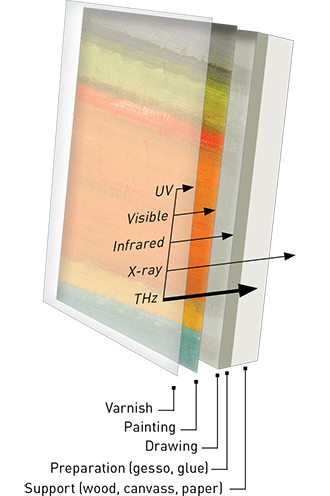
Cross-section of a typical painting, showing the penetration of different types of electromagnetic radiation. Terahertz rays travel farther into the layers than shorter frequencies of light. Although X-rays penetrate artifacts to greater depths, care must be taken with this ionizing radiation.
Terahertz techniques
Art conservators and archaeologists are no strangers to high technology, from X-ray fluorescence to ground-penetrating radar. Their use of the electromagnetic spectrum has had a gap, however, in the region from roughly 100 GHz to 10 THz in frequency. Fortunately, the explosive development of femtosecond lasers and terahertz technology that started a couple of decades ago brought much attention to that long-underused gap.
In 1998, Martin Koch, then of the Technical University at Brunswick (Braunschweig), Germany, beamed terahertz light at wood samples and demonstrated that terahertz time-domain imaging could detect variations in the density of wooden objects. Koch thus opened dendrochronology—tree-ring dating—to that spectral region.
In the 2000s, scientists who collaborated with the art world began to apply the new terahertz imaging and spectroscopy products to the artifacts of our common cultural heritage. As Koen Janssens of the University of Antwerp, Belgium, and his colleagues noted in a 2010 review article, refractive-index contrast in the terahertz region is greater than at visible and near-infrared wavelengths. This helps scientists distinguish between very thin paint layers, 20 to 50 μm in depth.
In its most basic form, nondestructive testing involves aiming short, fast pulses from a terahertz-range radiation source at an object and measuring the reflectance or transmission of that radiation. Non-ionizing terahertz rays don’t damage the pigments in paints and glazes and pose little or no danger to humans in the vicinity of the experiment.
Artifact researchers use two types of terahertz imaging: time-domain imaging (TDI) and, less commonly, frequency-modulated continuous-wave (FMCW) imaging, says J. Bianca Jackson, a research scientist based in New Jersey, USA. Jackson formerly studied terahertz imaging of art as a Marie Curie research fellow at the University of Reading, U.K., and worked on designing a portable terahertz optical coherence tomography system at the Capital Normal University, China.
TDI and time-domain spectroscopy (TDS) require sources of broadband pulsed terahertz light, while frequency-domain techniques require narrow-band light sources that can be either pulsed or continuous wave (CW). Investigators may select one or the other depending on various factors, including signal-to-noise ratio, acquisition time, peak-power requirements and cost effectiveness. Because the field is so new, there isn’t always a set answer.
Once image acquisition is complete, scientists can slice and dice the results depending on their objectives. To build a 2-D image from the raw data, researchers can divide the data in three or more frequency ranges and construct false-color images in red, green and blue (with additional colors as needed), similar to multispectral imaging. Specialists in the field call these top planar views C-scans. Three-dimensional data can be converted into cross-sections, known as B-scans, for measuring thicknesses of layers of paint, varnish and other materials.
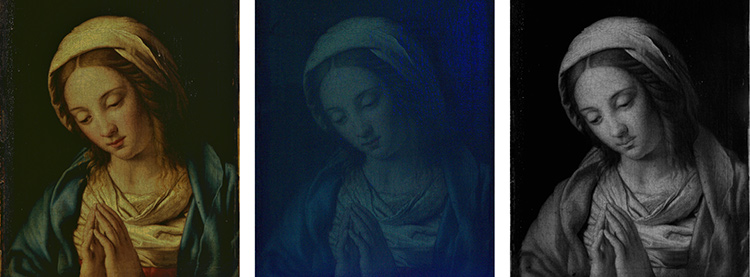 Three views of the painting Madonna in Preghiera, attributed to the workshop of Giovanni Battista Salvi da Sassoferrato: (left) visible-light photography, (center) ultraviolet fluorescence and (right) infrared reflectography. [Junliang Dong et al.]
Three views of the painting Madonna in Preghiera, attributed to the workshop of Giovanni Battista Salvi da Sassoferrato: (left) visible-light photography, (center) ultraviolet fluorescence and (right) infrared reflectography. [Junliang Dong et al.]
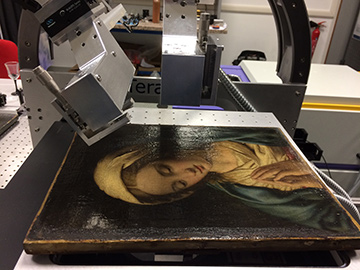 Terahertz imaging of the Madonna in Preghiera painting. [Junliang Dong et al.]
Terahertz imaging of the Madonna in Preghiera painting. [Junliang Dong et al.]
In one recent study, a team led by David S. Citrin of the Georgia Institute of Technology, USA, used a technique the researchers called sparsity-based terahertz reflectometry on an 17th-century oil painting, Madonna in Preghiera, from a French museum. The researchers acquired reflectance images of the painting with a commercially available terahertz emitter–detector system. Citrin credits his then graduate student, Junliang Dong, with doing extensive background reading in topics from acoustics to seismology and realizing that the mathematical technique of sparse deconvolution could do stratigraphy at all wavelengths.
The Georgia Tech group quantitatively measured six layers in the painting: the canvas support, the gesso (a binder to smooth out the surface of the canvas), two base layers of paint called imprimatura and underpainting, the so-called pictorial layer and the protective varnish. (The imprimatura acts as a sealant, keeping the oil from subsequent layers from soaking into the gesso and canvas, while the underpainting provides a general background tone to the picture.) Citrin says he and his colleagues could not distinguish individual image details within the pictorial layer—the delicate brushstrokes that created the hands, hair and facial features of the Madonna—because the paint was just too thin. The team did, however, discover that someone in the past had tried to restore part of the painting’s varnish.
Citrin, Dong and their colleagues, including Jackson, had to use a slightly different mathematical scheme, frequency-wavelet-domain deconvolution, to extract quantitative data from terahertz scans of a 20th-century oil painting on paperboard (After Fishing, by the Italian artist Ausonio Tanda). That artwork consisted of thick layers of paint, built up with a palette knife instead of a paintbrush, in a technique dubbed impasto.
 Images of After Fishing, a painting by Ausonio Tanda. (Top) Painting in visible light. (Center) X-ray transmission image of the painting. (Bottom) Terahertz time-domain image, based on raw data. The contrast denotes the peak amplitude of the reflected signal. [J. Dong et al., Opt. Express 24, 26972 (2016)]
Images of After Fishing, a painting by Ausonio Tanda. (Top) Painting in visible light. (Center) X-ray transmission image of the painting. (Bottom) Terahertz time-domain image, based on raw data. The contrast denotes the peak amplitude of the reflected signal. [J. Dong et al., Opt. Express 24, 26972 (2016)]
Case studies: From rock etchings to gilded icons
Though Jackson’s training is in applied physics, her mother’s 35-year career as an artist and public-school art history teacher left her with a deep appreciation of the world’s cultural heritage. While pursuing her doctorate at the University of Michigan, USA, she was working on terahertz studies of turbine blades when she heard a talk by OSA Fellow Gérard Mourou, who had visited the Louvre in France and the Hermitage in Russia. Mourou suggested that terahertz technology could examine artworks nondestructively. “Immediately I perked up, and everybody else’s eyes glazed over,” she recalls. After completing her Ph.D., she plunged full-time into terahertz studies of cultural artifacts, both prehistoric and modern.
In 2002, strange scratches were found in underground rocks at a British site known as Creswell Crags. Early examination found that the grooves, ranging in depth from a few hundred microns to a few millimeters, were covered with a patina from weathering and precipitation, which distinguished them from modern-day graffiti. Radioactive dating of the patina revealed that the markings were 12,000 to 15,000 years old—the first prehistoric rock etchings found in Great Britain. Twelve years later, Jackson and several colleagues from Great Britain used portable terahertz time-domain imaging equipment to depict the Paleolithic scratches in greater detail and extract a cross-section showing the calcite and the underlying limestone.
Artifacts don’t have to be thousands of years old to accumulate serious grime. Cosentino and colleagues at the Technical University of Denmark (DTU) performed multispectral imaging on a 14th-century painted wooden icon that was dull-looking and dirty. The anonymous work, owned by a Sicilian library, appeared to have some gold leaf along with the paint. Terahertz time-domain imaging revealed the extent of the solid gold leaf under the paint layers so that the conservators could avoid damaging it during the cleaning process. Terahertz rays also showed the interfaces between the paint and the primer and between the primer and the backing—displaying wood grain that had not been seen in more than 600 years.
One DTU alumna, Corinna L. Koch Dandelo, got up close and personal with two priceless works by the Italian Renaissance painter Fra Angelico. Dandelo, who was at the Centro de Investigaciones en Optica, Mexico, at the time, performed terahertz time-domain imaging on portions of the side panels of the artist’s Franciscan Triptych and a separate panel painting titled Lamentation over the Dead Christ. Art historians knew that someone in the 19th century had attempted to touch up the latter work with plaster, so the terahertz imaging revealed the nature of the patchwork. Since then, Dandelo became a postdoctoral fellow at the Centre de Recherche et de Restauration des Musées de France (C2RMF), which oversees artifact documentation and restoration efforts for more than 1,200 French museums. C2RMF was the first museum laboratory to delve into terahertz technology.
To improve their understanding of antiquities, scientists put modern replicas and analogs of these objects under the scrutiny of the same instruments. While still at DTU, Dandelo and her doctoral adviser, Peter Uhd Jepsen, used terahertz time-domain reflectometry to study a modern-day replica of a wood-backed tempera painting from the 15th century. The artists left parts of their copy of the painting uncovered, so that the scientists could test the materials individually and together. The gold leaf that the contemporary artists applied to this wood panel was, in some spots, thinner than the wavelength of the terahertz rays, so a small amount of light was able to penetrate the gilding.
Dandelo, Jepsen and several other researchers, including Kaori Fukunaga of Japan’s National Institute of Information and Communications Technology (NICT), also virtually sliced through several 21st-century lacquerware bowls to record their internal structures in terahertz light. Since the Asian lacquerware technique goes back some 7,000 years, the scientists’ results could help others understand the manufacturing process for antiquities that are too precious to sample destructively. Fukunaga has also used terahertz imaging to study the internal structure of 300-year-old Japanese folding screens.
 Yatsuhashi-zu Byōbu, six-panel folding screen by the Japanese artist Ogata Kōrin (1658-1716). [Metropolitan Museum of Art / National Institute of Information and Communications Technology]
Yatsuhashi-zu Byōbu, six-panel folding screen by the Japanese artist Ogata Kōrin (1658-1716). [Metropolitan Museum of Art / National Institute of Information and Communications Technology]
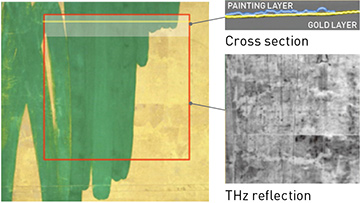 The almost uniform strong reflection of the terahertz imaging of the Kōrin masterpiece, conducted by Kaori Fukunaga, revealed that gold leaf extended under the paint. [Metropolitan Museum of Art / National Institute of Information and Communications Technology]
The almost uniform strong reflection of the terahertz imaging of the Kōrin masterpiece, conducted by Kaori Fukunaga, revealed that gold leaf extended under the paint. [Metropolitan Museum of Art / National Institute of Information and Communications Technology]
Bridging science and the arts
“What I’ve been doing is this kind of a bridge, bringing the academic background I have to the art sector,” says Cosentino, the CHSOS director. A physicist who has worked at DTU and the Metropolitan Museum of Art in New York, USA, Cosentino offers classes in various types of imaging and spectroscopy to art professionals, archaeologists and scientists involved in historic preservation.
Citrin says that only about a quarter of his laboratory time at the Georgia Tech campus in Metz, France, goes to cultural-heritage work; the other 75 percent is focused on nondestructive materials testing with industrial applications. Still, his group is doing terahertz studies of a 19th-century painting that shares some characteristics—dark tonality, delicate brush strokes—with the 17th-century Madonna portrait. Several art historians have also asked his team to identify the pigments in a 12th-century artwork.
According to Jackson, a significant challenge to terahertz spectroscopists is the relative lack of published standards. A few terahertz spectroscopic databases, including one compiled by NICT and other Japanese institutions, exist online, but their entries range in number from a couple dozen to a couple thousand—hardly enough to cover all the pigments, binders and residues that an archaeologist or art conservationist might encounter. Establishing standard spectra for materials in any wavelength regime is a challenge full of multi-instrument error analysis and grunt work. “You don’t get research funding for standardizing the spectrum for hematite,” Jackson says.
Another challenge, according to Cosentino and Dandelo, is that the emerging field of terahertz imaging doesn’t have the data analysis tools that usually come with analytical instruments for the more established spectral regions. The scanning is more user-friendly than the data analysis.
Cultural-heritage institutions tend to get less research funding than homeland security and medical applications, but Cosentino says he thinks the art world will benefit from the work going into those sectors.
The European Union has been funding terahertz cultural-heritage science, starting with a Framework Programme 7 project called CHARISMA, for Cultural Heritage Advanced Research Infrastructures: Synergy for a Multidisciplinary Approach to Conservation/Restoration. The next round of EU funding for the intersection of terahertz rays and artworks, through the Horizon 2020 program, has been dubbed IPERION CH, for Integrated Platform for the European Research Infrastructure on Cultural Heritage. Through this program, European museums can apply to have experts bring their terahertz equipment to their own laboratories for experiments, according to Jackson.
No one expects terahertz imaging and spectroscopy to replace other methods for probing artifacts, but rather to supplement them. As the technologies continue to develop, Jackson predicts, the cost of terahertz instruments should decrease even further, enabling more universities and museums to acquire the necessary instrumentation. Going forward, conservators will use a full spectrum of photonic tools to study the work habits of great artists, authenticate paintings and statues of questionable authorship, monitor the deterioration of masterpieces of art and archaeology, and discover new insights into our common cultural heritage.
Patricia Daukantas is a freelance science writer based in Greenbelt, Md., USA.
References and Resources
-
M. Koch. Opt. Photon. News 18(3), 20 (March 2007).
-
K. Janssens et al. Acc. Chem. Res. 43, 814 (2010).
-
S. Prati et al. Acc. Chem. Res. 43, 792 (2010).
-
J.B. Jackson et al. IEEE Trans. Terahertz Sci. Technol. 1, 220 (2011).
-
C.L.K. Dandelo et al. Studies in Conservation 60 (Supp. 1), S159-S166 (2015).
-
C.L.K. Dandelo et al. J. Infrared Milli. Terahertz Waves 38, 425 (2017).
-
K. Fukunaga. THz Technology Applied to Cultural Heritage in Practice (Springer Japan, 2016).
-
J.B. Jackson. Spectroscopy Europe 28(4), 14 (2016).
-
J. Dong et al. Opt. Express 24, 26972 (2016).
-
J. Dong et al. Sci. Rep. 7, 15098 (2017).

